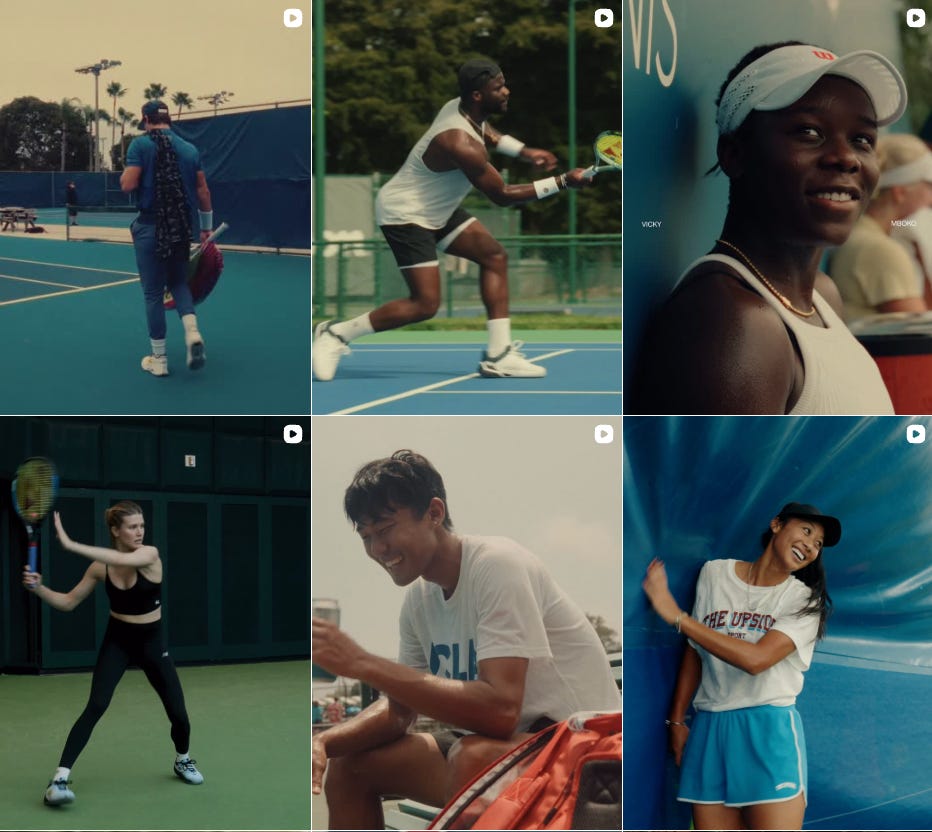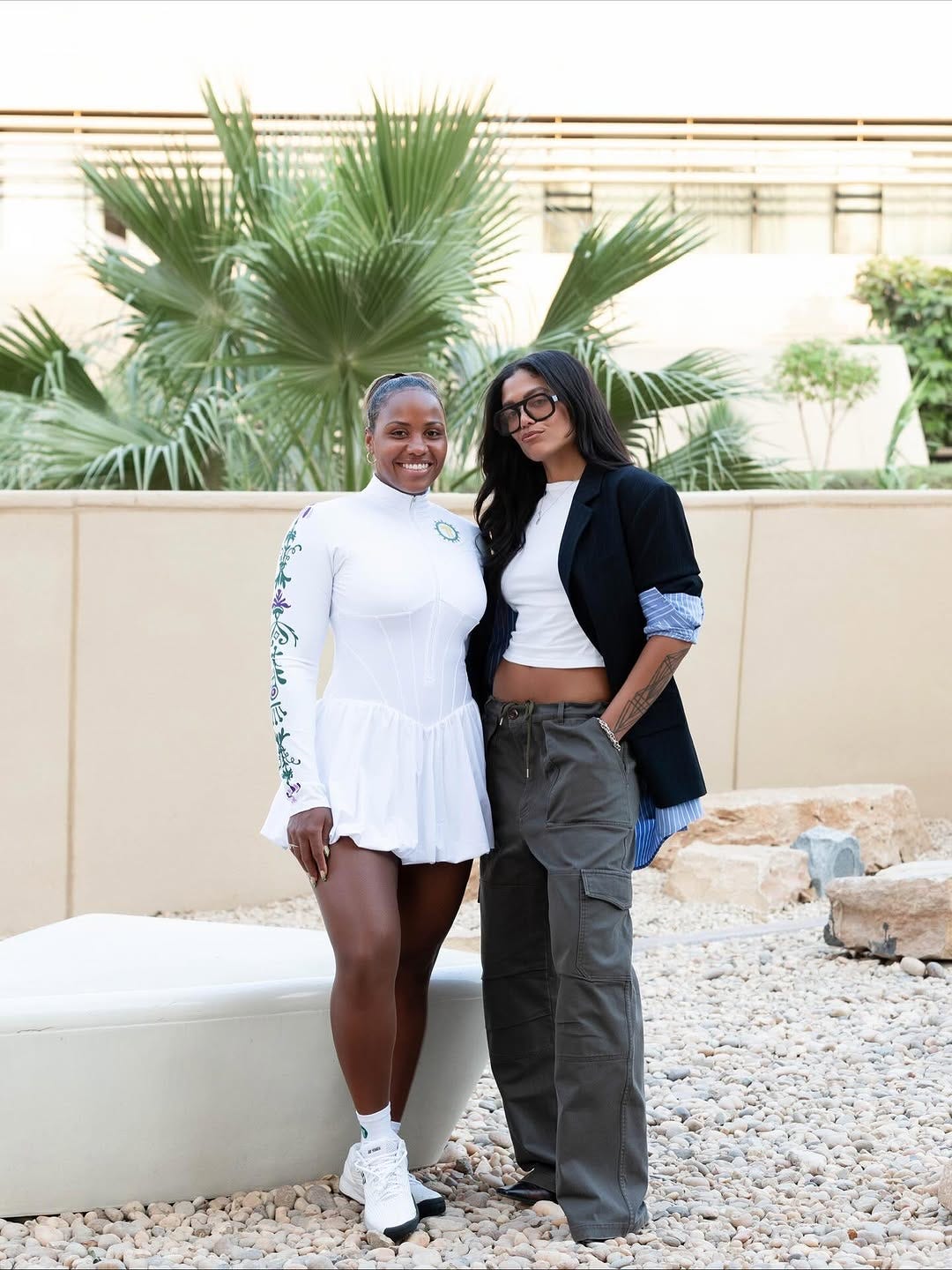The tennis tours' content conundrum
The tours limited what players and media can capture at events in order to protect their most important asset: access. But they've given us nothing to fill the void in return.
The tennis tours have a content problem—they’re just not aware of it.
Last week, a GQ profile of Taylor Fritz and Morgan Riddle featured an unexpected conversation about the limitations players and their famous partners (who bring many new fans to the sport) face when trying to capture content at tournaments.
While talking about the pressure he feels to build his personal brand on social media, with limited time and less of a natural inclination to do so than Riddle, Fritz also pointed out how current tournament rules about on-site content capture make it difficult. His complaints echo those that I’ve been hearing from people across the sport for the past few months, including those who work with players directly and people running newer tennis media brands.
“A lot of the tournaments are saying, ‘You either have to have won a Slam or have 1 or 2 million followers to even be allowed a videographer on tour,’ which I think is absurd,” said Fritz. “How are you ever going to have a million followers if you don’t have someone capturing decent content to build your brand?” Indeed, only a handful of active players—like Djokovic, Alcaraz, Sinner, Sabalenka, Swiatek, and Gauff—meet that criteria. Fritz, who’s No. 4 in the world and should presumably be granted the same freedoms on that basis alone, only has 875k followers on Instagram.
The limitations affect WAGs too and, from my reporting, it’s clear that they’re also one of the reasons for this content capture crackdown. As they started to proliferate, creating content for their vlogs that often includes brief snapshots of their partners playing, the organizations that run these tournaments (like the USTA for the US Open or the ATP and WTA Tours for Masters 1000s and below) felt they had to step in to protect their relationships with broadcasters. As innocuous as it may sound, a brief glimpse of Fritz hitting a ball on court is technically copyright infringement against whoever has the broadcasting rights for the tournament he’s playing in.
“I’ve gotten multiple copyright strikes against my account when I post videos of him,” Riddle said in the GQ piece. “In the last three years, the tournaments and the tour have gotten really strict with where you can film and where you can’t. I’m not allowed to have a camera in the box anymore, whereas a couple of years ago, none of those rules were in place.”
While none of the organizations running the various tournaments have outright barred the WAGs from creating vlogs, they’ve certainly made it more difficult to do so.
“We’ve seen an influx of player credential requests that are meant to serve as content capture,” explained one person involved in the tournaments who spoke under the condition of anonymity. “How do we solve for an individual who has a player guest credential but wants to sit in the photo pit or film from the stands for what is essentially a new form of media?”
The solution was setting these extreme new guidelines that a player must meet in order to bring someone in to film, which were confirmed to me by multiple people working with the tours—though one disagreed that someone as highly ranked as Fritz would have a problem.
Ironically, it may have been one of tennis’s top stars, Jannik Sinner, who lit the spark for these new terms. Two sources tell me that when he wanted to bring a videographer to the Australian Open for his vlog, even he was faced with push back. In order to plead his case, he supposedly showed some of the WAGs’ vlogs as proof that he, too, deserved access. From there, the ultra-exclusive Grand Slam winner and follower count limits were set for the Slams.
Some people believe the tours and tournament organizers are threatened by the idea of giving up their bread and butter—access—to new media and even the athletes themselves.
“All of the WAGs’ vlogs became super popular and the WTA and ATP saw all that and instead of saying ‘Omg this is great, let’s let more people do this,’ they went the opposite route and were like no, we want to do this,” says Anastasia Folorunso, the founder of the Ground Pass podcast.
What am I watching here?
The problem is, they never delivered. Some of the BTS content you can get from watching the WAGS’ vlogs (like Fritz talking about why he’s superstitious about bageling someone and prefers a breadstick, if given the option) is infinitely better than the jokey, TikTok-style video content that the tours continue to shove down our throats. Put simply: it’s not what any tennis fans I know want. Show us what it’s like behind-the-scenes of these events, what the players do on their “days off,” ask them real questions instead of, “Which would you pick: Ice Spice, croissant, or Ben Shelton?” Yeah, that really happened and I lost a few brain cells writing it out.
Much of this forgettable content comes from the ATP’s partnership with Overtime earlier this year. The stated goal was to bring behind-the-scenes tennis content to Overtime’s supposedly 100M+ millennial and Gen Z/Alpha audience — but it’s actually only shared between the ATP’s Instagram and a specialized account called @overtimetennis which has a mere 35.4K followers. Though the content is hosted by a charismatic and funny guy named West Von, it’s completely failed to deliver any true insights into what life is like as a tennis player.
“I’m so sorry to the guy who hosts it, he’s very sweet, but that content is not it,” said Folorunso. “I shouldn’t have to think about what [a piece of content] means? Once that happens, I’ve scrolled past and you’ve lost me.”
Folorunso believes the tours are trying too hard to appeal to Gen-Z, an audience they’ve been struggling to court for years. A recent report from the UK broadcasting watchdog Ofcom found that tennis viewership among people aged 18-34 has declined from a paltry 13% to 10% since 2019. “You can’t alienate your core audience in the search of a new one before the new one even understands what you are,” she said. “You’ll lose your current audience before you even have the new one, so then you’re left with nothing.”
Just this morning, the ATP announced the launch of its “TikTok Creator Network,” a group of TikTokers like Rafael Escrig, Sespo, and Yuvi Randhawa, most of whom seem to have no clear interest in tennis. Their content will debut at the ATP Finals in Turin next week and I’m eager (with a devilish glint in my eye) to see what comes of it.
The WTA isn’t any better at this, by the way. Though they’ve included a little bit of the hollow “lolz” content that the ATP has made its brand, most of what they post is an uninventive slew of match scores and highlights. So much of it, in fact, that I find my thumb speed rushing past it all on Instagram because it’s so uninteresting. Sure, there’s a place for the basics, but it doesn’t do anything to draw in new fans or engage current fans more deeply—especially when there’s so much of the same thing.
A cursed credential system
Overall, we’re starved for tennis content that scratches more than the surface. Freeing up more players and new media to provide that would only benefit the sport.
“All of the Grand Slams are really hard to get connections to,” said Matthew Calvis, a tennis-focused filmmaker who has worked on branded projects featuring Roger Federer, Naomi Osaka, and Frances Tiafoe and launched a YouTube series called Insiders earlier this year that he hopes will fill the void of behind-the-scenes player content. When he does get in, he’s stunned by the lack of diversity: “The press room is pretty much all guys over 50, even the photographers. It’s a pretty dated sport, it needs more youthful energy.”
The USTA tried to open things up by launching a new content creator credential for the US Open this year but (similar to the ATP’s new program) they made the head-scratching decision to open it up mostly to content creators outside of sports—think lifestyle, food, fashion, etc. “It was their way of acknowledging that that kind of content is valuable for the tournaments,” said one person familiar with the decision.
When Folorunso, of Ground Pass, was introduced to someone at the credentialing office she was surprised to hear about this new option as it wasn’t well advertised. Still, she said, “I got the sense that they didn’t quite know which credential was the right fit for me,” despite the fact that the creator credential was technically open to podcasters. When she came across content from creators who had gotten the pass, it was evident that, despite having more followers than her, they didn’t even know how tennis worked. “How are you supposed to talk to your audience about coming to a tennis tournament if you know nothing about it?”
Credentialing at tournaments is so unnecessarily confusing and difficult that Calvis tries to avoid tournaments altogether these days. “If you get a media credential you’re not allowed in the player’s lounge, and if you get a player’s credential you’re not allowed to film in some of the areas where media can film,” he explained. Instead, he’s made connections with players and their teams directly and films them in-between tournaments when they’re practicing.
Some players, like Sinner, Aryna Sabalenka, and Daria Kasatkina, have taken matters into their own hands by launching personal brand-building vlogs, and a few more players are expected to do so in 2026. But it’s an expensive and time-consuming undertaking, says Calvis: “I’ve talked to people that just don’t have the resources or know how to get started.”
Change is gonna come, maybe?
What makes this problem particularly difficult to solve is that tennis is one of the most segmented sports in the world in terms of governing bodies. Each Grand Slam has its own set of rules and, while you’d assume there’d be more consistency at the ATP or WTA-run events below the Slams, most people say that’s not the case. Where one smaller tournament might let you film from the stands and interview a top player, another will simply hand you a ground pass and a dream. Then there’s the complicating factor of broadcasting rights, which differ across all the tournaments, particularly the Slams.
“We’re trying to balance commercial obligations with the rise of digital media,” said the tournament official. “These things are always being adapted and like many sports, we’re still evolving the rules.”
“Policies have not caught up with how content is being consumed,” said another person involved in the US Open, on condition of anonymity, “but that is a conversation for someone who gets paid way more than me.”
Folorunso made a great analogy to the fashion industry roughly 15 years ago, when influencers started storming the scene and traditional publications and their editors balked at the thought of them being involved—let alone taking over. Today, the editors are influencers, and the front row is littered with more new media than old. “Tennis is at the same turning point and things are going to change no matter what,” she said. “It’s just a question of, will it take them a few years or 10 years to figure it out?”
Off-Court
I already talked a lot, so here’s a quick round-up of off-court news…
Taylor Townsend launched her eponymous kit label TT by Taylor Townsend at the French Open earlier this year with the help of Atlanta-based designer Talton Alexander-John Ballard. But nothing good lasts forever—she’s since replaced him with the creative director and designer Dominique Wells, who also works with the Washington Spirit. A source tell me Wells is purely slated to oversee Townsend’s new kits, not act as a creative director for everything she wears off-court.
As you may have seen, I covered the WTA Finals portraits in Riyadh this week for the Financial Times and they really upped the fashion ante. The organization brought in high fashion, a photographer who’s appeared in Vogue and Elle, and an all-female creative team with extensive experience on fashion photoshoots. The result is definitely an upgrade from years past, but I’m still waiting for something less stiff and styling that’s a bit more cohesive (a struggle when you have a shoot stylist trying to work with players’ individual stylists). My winners: Iga Swiatek for the thoughtfulness behind her look (a custom Saudi-designed dress from Lurline paired with Polish-designed shoes by Vanda Novak) and Coco Gauff because her and custom Miu Miu can do no wrong.
Dreams really do come true—you can now eat Novak Djokovic-approved fake popcorn! It was announced last week that he’s the lead investor and co-founder of Cob, a corn-free, gluten-free ancient grain snack akin to popcorn. His co-founder Jessica Davidoff, who previously founded the clothing hanger brand Cove (the old hangers-to-popcorn pipeline), was inspired to create the Sorghum-based product after a long medical journey with her son led her to the ancient grain. The product launches in four flavors that I’m pretty keen to try: cacio e pepe, Mediterranean herb, seriously cheesy and olive oil and pink salt. Stay tuned for the official taste test.
That’s it from me today! I have a few big tennis interviews and some brand stories in the works that I’m really excited about. Stay tuned, and send any tips to jessica@hard-court.com.








The WAGs are right there with me, blabbing (at an almost imperceptible volume) while I cook dinner. As one YouTuber pointed out, "Jannik is so good he says '6 days until finals' instead of 'Round of 16.' Bro knows he's going to win 😂." King behavior
“You can’t alienate your core audience in the search of a new one before the new one even understands what you are."
This is a great statement to describe sports in general right now. Loudly chasing the attention of Gen-Z, and the next generation, all while removing the likes of the older generations.